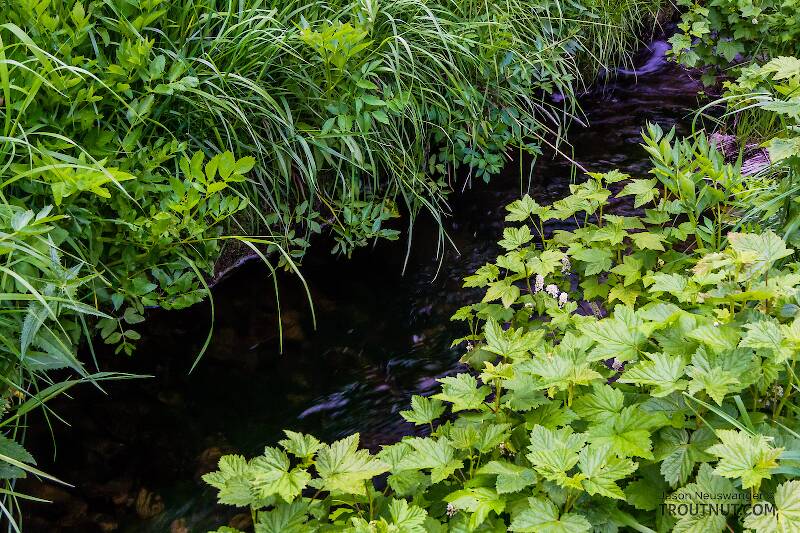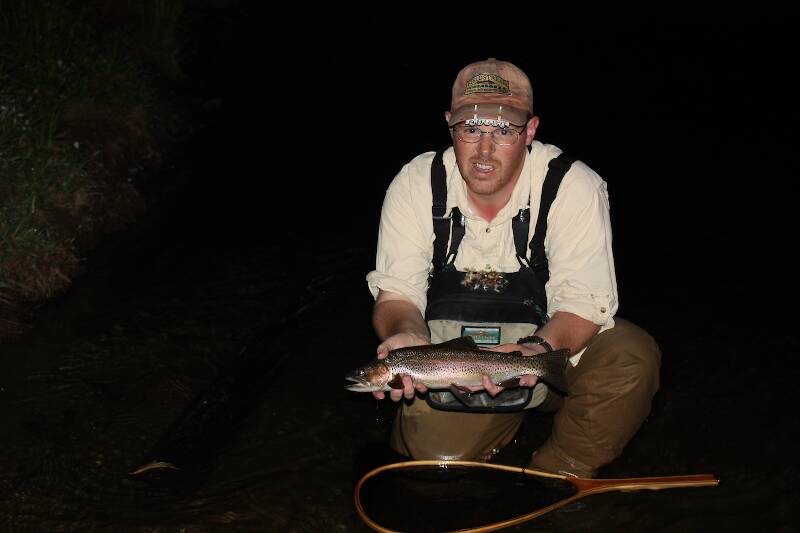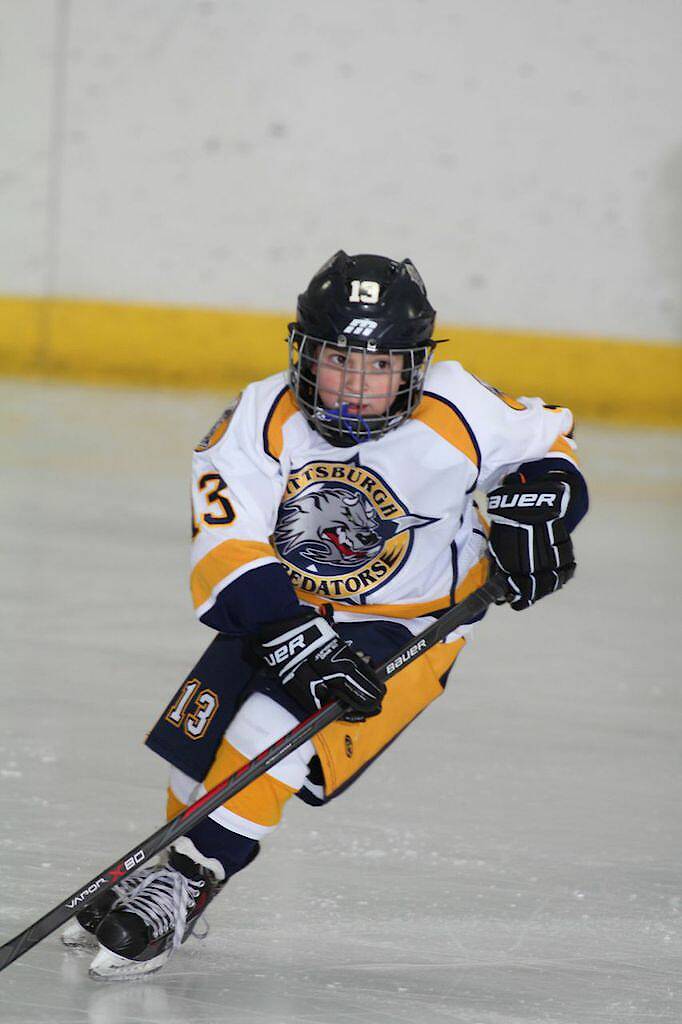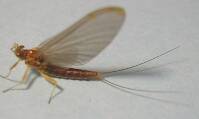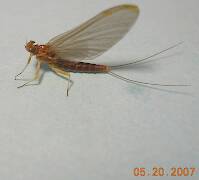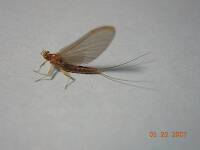
Hex Mayflies
Hexagenia limbata
The famous nocturnal Hex hatch of the Midwest (and a few other lucky locations) stirs to the surface mythically large brown trout that only touch streamers for the rest of the year.
Featured on the forum

It's only barely visible in one of my pictures, but I confirmed under the microscope that this one has a prosternal horn and the antennae are mid-way between the eyes and front of the head capsule.
I'm calling this one Pycnopsyche, but it's a bit perplexing. It seems to key definitively to at least Couplet 8 of the Key to Genera of Limnephilidae Larvae. That narrows it down to three genera, and the case seems wrong for the other two. The case looks right for Pycnopsyche, and it fits one of the key characteristics: "Abdominal sternum II without chloride epithelium and abdominal segment IX with only single seta on each side of dorsal sclerite." However, the characteristic "metanotal sa1 sclerites not fused, although often contiguous" does not seem to fit well. Those sclerites sure look fused to me, although I can make out a thin groove in the touching halves in the anterior half under the microscope. Perhaps this is a regional variation.
The only species of Pycnopsyche documented in Washington state is Pycnopsyche guttifera, and the colors and markings around the head of this specimen seem to match very well a specimen of that species from Massachusetts on Bugguide. So I am placing it in that species for now.
Whatever species this is, I photographed another specimen of seemingly the same species from the same spot a couple months later.
I'm calling this one Pycnopsyche, but it's a bit perplexing. It seems to key definitively to at least Couplet 8 of the Key to Genera of Limnephilidae Larvae. That narrows it down to three genera, and the case seems wrong for the other two. The case looks right for Pycnopsyche, and it fits one of the key characteristics: "Abdominal sternum II without chloride epithelium and abdominal segment IX with only single seta on each side of dorsal sclerite." However, the characteristic "metanotal sa1 sclerites not fused, although often contiguous" does not seem to fit well. Those sclerites sure look fused to me, although I can make out a thin groove in the touching halves in the anterior half under the microscope. Perhaps this is a regional variation.
The only species of Pycnopsyche documented in Washington state is Pycnopsyche guttifera, and the colors and markings around the head of this specimen seem to match very well a specimen of that species from Massachusetts on Bugguide. So I am placing it in that species for now.
Whatever species this is, I photographed another specimen of seemingly the same species from the same spot a couple months later.

Troutnut is a project started in 2003 by salmonid ecologist Jason "Troutnut" Neuswanger to help anglers and
fly tyers unabashedly embrace the entomological side of the sport. Learn more about Troutnut or
support the project for an enhanced experience here.
Allan on Sep 9, 2011September 9th, 2011, 3:26 pm EDT
In another thread the poster asked what 'DST Quills' were. I identified the acronym and here's an explanation of the material itself:
DST(Dyed Specially Treated) Quills are actually peccary/javalina hairs. I search for a very specific type of hair quality. For these 'quills', the skins I seek must have a large patch of hair that's at least 5 inches long. The hair must also have a white/cream base of a good 2 inches so there'll be enough of the quill with the dyed color to work with. Much shorter and finer hairs are used for tails, feelers, antennae and legs. Anyway, once I get the skin I treat it in a special way, dye it in a way that does not harm the inherent property of the hairs, and then treat it again. The treatments make the quills/hairs easier to dye, softer, and more pliable. I think it makes them stronger but I can't be sure about that. There's no question that they are much stronger then peacock or stripped hackle quill, are much easier to work with and offer similar segmentation to the stripped hackle but truthfully not quite the same as the peacock.
I hope I've explained these DST Quills well enough. If anyone would like to try a sample pack with various colors, just email or PM your snail mail address to me. All I ask is that, after you've tyed with the material as suggested in the accompanying 'tying tips' sheet, you let me know what you honestly think of it.
Allan
DST(Dyed Specially Treated) Quills are actually peccary/javalina hairs. I search for a very specific type of hair quality. For these 'quills', the skins I seek must have a large patch of hair that's at least 5 inches long. The hair must also have a white/cream base of a good 2 inches so there'll be enough of the quill with the dyed color to work with. Much shorter and finer hairs are used for tails, feelers, antennae and legs. Anyway, once I get the skin I treat it in a special way, dye it in a way that does not harm the inherent property of the hairs, and then treat it again. The treatments make the quills/hairs easier to dye, softer, and more pliable. I think it makes them stronger but I can't be sure about that. There's no question that they are much stronger then peacock or stripped hackle quill, are much easier to work with and offer similar segmentation to the stripped hackle but truthfully not quite the same as the peacock.
I hope I've explained these DST Quills well enough. If anyone would like to try a sample pack with various colors, just email or PM your snail mail address to me. All I ask is that, after you've tyed with the material as suggested in the accompanying 'tying tips' sheet, you let me know what you honestly think of it.
Allan
Troutnut on Sep 10, 2011September 10th, 2011, 11:37 am EDT
For anyone who's wondering, I usually don't allow people to pitch commercial products here, but Allan asked me beforehand for permission, and what he had to say was pretty interesting & relevant to what others were wondering in another thread.
Allan I'm curious, how do you come across a variety of peccary/javalina hairs to peruse? Do you travel to South America or are there North American breeders? I've never heard of them used for fly tying, but it sounds like something fun to try.
Allan I'm curious, how do you come across a variety of peccary/javalina hairs to peruse? Do you travel to South America or are there North American breeders? I've never heard of them used for fly tying, but it sounds like something fun to try.
Jason Neuswanger, Ph.D.
Troutnut and salmonid ecologist
Troutnut and salmonid ecologist
JOHNW on Sep 10, 2011September 10th, 2011, 5:48 pm EDT
@Allan,
I used to use a product called McCleans (-sp?) quills and then my local provider could no find them. How do these compare?
@ Troutnut
A local guy once extolled the virtues of peccary/javalina although he was using it for legs on realistic nymphs and antennae on caddis. I bet the folks in Wes Texas would be glad to have a use for the javalina. From what I understand they are quite the destructive force and not very good for eating.
JW
I used to use a product called McCleans (-sp?) quills and then my local provider could no find them. How do these compare?
@ Troutnut
A local guy once extolled the virtues of peccary/javalina although he was using it for legs on realistic nymphs and antennae on caddis. I bet the folks in Wes Texas would be glad to have a use for the javalina. From what I understand they are quite the destructive force and not very good for eating.
JW
"old habits are hard to kill once you have gray in your beard" -Old Red Barn
Gutcutter on Sep 11, 2011September 11th, 2011, 5:44 am EDT
I would like some samples of the DST quills and will PM you, Allan.
I used "natural" peccary for years as antennae in caddis pupae and adults and never even thought about wrapping them as a "quill" type body.
Like JohnW, I use "Freestone Flies McLean's Quill Body" (Rawlins, WY) which I believe is porcupine. It doesn't flatten well enough on small hooks because I have to use too much pressure and I will weaken, bend and sometimes break the hook enough to make them a frustration for me. They work well with larger patterns and come in shades to match most hatches in 12-18.
For smaller flies, I use "D's Flyes Quills II" (Denver, CO) which need to be soaked before use. These work well on sizes 18-22 but are harder to use and seem quite fragile - splitting/cracking/breaking with any tension other than "correct" tension. And that seems to vary with each individual quill.
They both look great when done correctly, but they must be coated with head cement both before and after they are wrapped. Kind of pain in the ass for me as I like to be able to crank out a dozen flies of the same pattern in 20-30 minutes, but most importantly, they give my flies a very thin and ribbed abdomen that is difficult to reproduce with anything other than biots.
I'm too lazy (really just an excuse) to use the best tool for the job - a stripped peacock. I have seen them at Phil Baldacchino's Kettle Creek Tackle Shop - natural and dyed. If Goose and I make it up there in the fall, I'll pick some up and let you know what I think.
I look forward to trying out the DST quills, as well.
Sorry for the ramble...
I used "natural" peccary for years as antennae in caddis pupae and adults and never even thought about wrapping them as a "quill" type body.
Like JohnW, I use "Freestone Flies McLean's Quill Body" (Rawlins, WY) which I believe is porcupine. It doesn't flatten well enough on small hooks because I have to use too much pressure and I will weaken, bend and sometimes break the hook enough to make them a frustration for me. They work well with larger patterns and come in shades to match most hatches in 12-18.
For smaller flies, I use "D's Flyes Quills II" (Denver, CO) which need to be soaked before use. These work well on sizes 18-22 but are harder to use and seem quite fragile - splitting/cracking/breaking with any tension other than "correct" tension. And that seems to vary with each individual quill.
They both look great when done correctly, but they must be coated with head cement both before and after they are wrapped. Kind of pain in the ass for me as I like to be able to crank out a dozen flies of the same pattern in 20-30 minutes, but most importantly, they give my flies a very thin and ribbed abdomen that is difficult to reproduce with anything other than biots.
I'm too lazy (really just an excuse) to use the best tool for the job - a stripped peacock. I have seen them at Phil Baldacchino's Kettle Creek Tackle Shop - natural and dyed. If Goose and I make it up there in the fall, I'll pick some up and let you know what I think.
I look forward to trying out the DST quills, as well.
Sorry for the ramble...
All men who fish may in turn be divided into two parts: those who fish for trout and those who don't. Trout fishermen are a race apart: they are a dedicated crew- indolent, improvident, and quietly mad.
-Robert Traver, Trout Madness
-Robert Traver, Trout Madness
Allan on Sep 11, 2011September 11th, 2011, 10:32 am EDT
Answering some questions:
Jason - "how do you come across a variety of peccary/javalina hairs to peruse? Do you travel to South America or are there North American breeders? I've never heard of them used for fly tying, but it sounds like something fun to try".
--- I've tried to make some contacts among taxidermists in the SW. I try and explain what type of hair I need and ask if they have a skin with hair that meets my description. When I get what I've bought, if the skin has hair that's good, it gets used. If not, it gets tossed.
John W - "I used to use a product called McCleans (-sp?) quills and then my local provider could no find them. How do these compare?"
--- McCleans product is actually 'porcupine guard hairs', not quills. I have not used it but they and my DST quills are significantly different. But I'll let you be the judge.
Gutcutter -
I suspect that the narrower the 'quill', be it McClean's product or my DSTs, the smaller fly it's possible to tye. As you said, the larger flies, sizes say 10 - 16, seem most easily tyed. Smaller stuff, say 18 - 20 are tougher and you have to play with the material(as I describe in the TIP sheet). Then in the even smaller sizes you probably need to find an alternative. However, if someone does tye in the 20 and smaller range, I can prepare DST Quills from much finer raw material, same animal, which will exceed the quality of the material they now use. A tyer does not need 2+ inches of colored quill for a size 22, 24, 26 size fly. A 'quill' with a usable color length of 3/4 or 1/2 inch long will wrap flies that small.
But you try it and you be the judge.
Hope the above information helps.
Allan
Jason - "how do you come across a variety of peccary/javalina hairs to peruse? Do you travel to South America or are there North American breeders? I've never heard of them used for fly tying, but it sounds like something fun to try".
--- I've tried to make some contacts among taxidermists in the SW. I try and explain what type of hair I need and ask if they have a skin with hair that meets my description. When I get what I've bought, if the skin has hair that's good, it gets used. If not, it gets tossed.
John W - "I used to use a product called McCleans (-sp?) quills and then my local provider could no find them. How do these compare?"
--- McCleans product is actually 'porcupine guard hairs', not quills. I have not used it but they and my DST quills are significantly different. But I'll let you be the judge.
Gutcutter -
I suspect that the narrower the 'quill', be it McClean's product or my DSTs, the smaller fly it's possible to tye. As you said, the larger flies, sizes say 10 - 16, seem most easily tyed. Smaller stuff, say 18 - 20 are tougher and you have to play with the material(as I describe in the TIP sheet). Then in the even smaller sizes you probably need to find an alternative. However, if someone does tye in the 20 and smaller range, I can prepare DST Quills from much finer raw material, same animal, which will exceed the quality of the material they now use. A tyer does not need 2+ inches of colored quill for a size 22, 24, 26 size fly. A 'quill' with a usable color length of 3/4 or 1/2 inch long will wrap flies that small.
But you try it and you be the judge.
Hope the above information helps.
Allan
JOHNW on Sep 11, 2011September 11th, 2011, 2:33 pm EDT
Allan,
PM inbound.
PM inbound.
"old habits are hard to kill once you have gray in your beard" -Old Red Barn
JOHNW on May 22, 2013May 22nd, 2013, 7:46 am EDT
THought I'd dredge this one up as I recently rediscovered the sample pack Allan had sent me.
I have had quite a nice time tying with these and the really are a step above the traditional stripped hackle quill. They flatten out very nicely and I was able to get several flies out of a single quill. They are nowhere near as fussy in terms of needing an absolutely smooth base either. Although I do recommend getting the base as smooth as you can.
AS for durability while fishing I am well pleased. I left a few "unfinished to see how they would hold up and the testing was somewhat inconclusive as the fly was lost to trees or fish before a sufficient sample size was obtained. For those I did "treat" i applied a very thin coat of loon UV knot sense and they are about bomb proof. THe wings and hackle are gone and the bodies look pretty much pristine.
Your milage may vary, but I like em.
JW
I have had quite a nice time tying with these and the really are a step above the traditional stripped hackle quill. They flatten out very nicely and I was able to get several flies out of a single quill. They are nowhere near as fussy in terms of needing an absolutely smooth base either. Although I do recommend getting the base as smooth as you can.
AS for durability while fishing I am well pleased. I left a few "unfinished to see how they would hold up and the testing was somewhat inconclusive as the fly was lost to trees or fish before a sufficient sample size was obtained. For those I did "treat" i applied a very thin coat of loon UV knot sense and they are about bomb proof. THe wings and hackle are gone and the bodies look pretty much pristine.
Your milage may vary, but I like em.
JW
"old habits are hard to kill once you have gray in your beard" -Old Red Barn
Martinlf on May 22, 2013May 22nd, 2013, 8:27 am EDT
JW, and others, I too liked them.
"He spread them a yard and a half. 'And every one that got away is this big.'"
--Fred Chappell
--Fred Chappell
Oldredbarn on May 28, 2013May 28th, 2013, 1:56 pm EDT
I first heard of peccary, probably in the same place Tony did, from Chris Helm. I purchased them for split tails on smaller flies.
"Even when my best efforts fail it's a satisfying challenge, and that, after all, is the essence of fly fishing." -Chauncy Lively
"Envy not the man who lives beside the river, but the man the river flows through." Joseph T Heywood
"Envy not the man who lives beside the river, but the man the river flows through." Joseph T Heywood
Quick Reply
Related Discussions
Topic
Replies
Last Reply
Invitation to the 30th Slovenian Open Fly Tying Championship 2017
In General Discussion by Lucky_luke
In General Discussion by Lucky_luke
0
Jan 5, 2017
by Lucky_luke
by Lucky_luke
9
Apr 29, 2009
by Taxon
by Taxon
Invitation to the 32nd Slovenian Open Fly Tying Championship 2019
In General Discussion by Lucky_luke
In General Discussion by Lucky_luke
0
Jan 13, 2019
by Lucky_luke
by Lucky_luke
Invitation to the 33rd Slovenian Open Fly Tying Championship 2020
In General Discussion by Lucky_luke
In General Discussion by Lucky_luke
0
Jan 17, 2020
by Lucky_luke
by Lucky_luke

